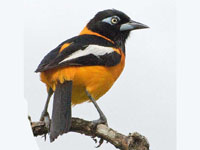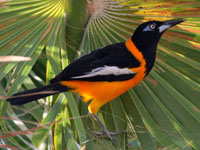THE WORLD BIRDS - An Online Bird Book
ICTERIDAE
Orioles
Order Passeriformes Family Icteridae
ICTERIDAE
The Icterids are a group of small to medium-sized, often colorful birds, restricted to the New World. Most species have black as a predominant plumage color, often enlivened by yellow, orange or red. The majority of icterid species live in the tropics, although there are a number of temperate forms. They inhabit a range of habitats, including scrub, swamp, forest, and savannah. Temperate species are migratory. Icterids are variable in size, and often display considerable sexual dimorphism. Their size varies 15-52 cm. One unusual adaptation shared is they can open their bills strongly rather than passively, allowing them to force open gaps to obtain otherwise hidden food. Some use their gaping motion to open the skins of fruit to obtain the soft insides, and have long bills adapted to the process. Others such as cowbirds have shorter stubbier bills for crushing seeds. orioles will drink nectar. The nesting habits of these birds are similarly variable.
The Icteridae are described in the following articles: black birds, caciques, cowbirds, grackles, meadow lark, and orioles.
The Icteridae are described in the following articles: black birds, caciques, cowbirds, grackles, meadow lark, and orioles.
Orioles
Order Passeriformes Family Icteridae
The New World orioles of family Icteridae, genus Icterus are not related to Old World orioles of family Oriolidae, but are strikingly similar in size, diet, behavior, and their strongly contrasting plumage, a good example of convergent evolution. The males are typically black and yellow or orange, with white markings; the plumage of females and immature birds is duller. They are generally slender with long tails and a pointed bill. Most range from 18 to 25 cm long. The Venezuelan troupial can reach 27 cm long.
In Icterus genus there are 29 species name orioles and 3 troupials. The troupials are named from a greek word that means troops which is appropriate because the troupials live in flocks. Even though the troupials and orioles are in the same genus, the troupials are very different in a their approach to nests. While the orioles all have woven elongated pouches for nests, the troupials doe not build their own next, instead they use an old one or evict a current owner. And they are fussy about the type of nest they use - the entryway should be covered. With such a difference between the orioles on troupials, perhaps they should not be in the same genus. Another minor difference is that all New World orioles have dark eyes while the troupials have yellow eyes.
Orioles and troupials mainly eat insects, and usually also nectar and fruit. Sliced whole fruit can be used to attract orioles to bird feeders and many species will also visit hummingbird feeders for the nectar. Chicks need high protein food and thus are fed mostly insects and spiders. The Icterus species are do not require a specific habitats. Many like to be near water, none like dense forests, and quite a few like dry areas. Species nesting in areas with cold winters are migratory.
Genus Icterus
The male orioles are typically black and yellow/orange with a little white. Females are duller.
Oriole,_Altamira Icterus gularis
Description: The Altamira oriole has a black back, wings, bib, lores, and bill. The head, nape, and underparts are orange. It has a white wingbar. Male and female are similar. The Altamira oriole is 25 cm long, which makes it one of the longest species of it genus. The similar male hooded oriole has more black on cheeks than Altamira. The similar spot-breasted oriole has spots on its breast.
Range: Texas to Central America.
Habitat: Semi-arid areas with scattered trees, also open riparian woodland.
Diet: Fruits, insects (especially grasshoppers and caterpillars).
Conservation status: Least Concern.
Image by: 1) Aaron_Maizlish 2) Bill Bouton - Texas 3) Hollingsworth of the USWS 4) Dominic Sherony Range: Texas to Central America.
Habitat: Semi-arid areas with scattered trees, also open riparian woodland.
Diet: Fruits, insects (especially grasshoppers and caterpillars).
Conservation status: Least Concern.
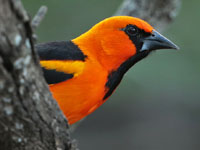


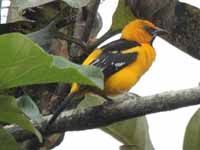
Oriole,_Audubon's Icterus graduacauda
Description: Audubon's oriole has a yellow back with greenish tinge. It has a black hood, wings, and tail. The bill is shiny black and the underparts are yellow. The female is similar to the male with slightly more green on the back. The Audubon's oriole is up to 24 cm long. The similar male Scott's oriole has a black back. The female Scott's oriole does not have a black head.
Range: Southeastern Texas, Mexican Atlantic and Pacific coasts.
Habitat: Dense evergreen forests and thickets, preferring riparian (riverside) areas.
Diet: Insects, spiders, fruits, seeds. It uses the bill to probe for insects in dead wood.
Conservation status: Least Concern.
Image by: 1) Jerry Oldenettel - Mexico 2, 3) Bill Bouton - Texas 4) Andy_Morffew - TexasRange: Southeastern Texas, Mexican Atlantic and Pacific coasts.
Habitat: Dense evergreen forests and thickets, preferring riparian (riverside) areas.
Diet: Insects, spiders, fruits, seeds. It uses the bill to probe for insects in dead wood.
Conservation status: Least Concern.
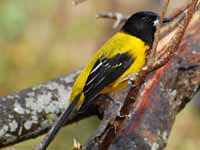



Oriole,_Bahama Icterus northropi
Description: The Bahama oriole has a black hood, breast, wings, and tail. There is a white wing-bar; the rest of the plumage is yellow. It has a black bill and blue-grey legs. The Bahama oriole is up to 22 cm long.
Range: Andros (island in Bahamas).
Habitat: Pine and broadleaf forests and more open areas close to houses.
Diet: Insects, fruits, nectar.
Conservation status: It is listed as Endangered because of habitat loss and introduced predators such as dogs, cats, hogs, and rats.
Image by:
1) mxmerceRange: Andros (island in Bahamas).
Habitat: Pine and broadleaf forests and more open areas close to houses.
Diet: Insects, fruits, nectar.
Conservation status: It is listed as Endangered because of habitat loss and introduced predators such as dogs, cats, hogs, and rats.
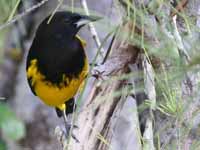
Oriole,_Baltimore Icterus galbula
Description: The male Baltimore oriole has a black hood, back, wings, and upper-tail. He has yellowish-orange to reddish-orange underparts and shoulders. The female has yellow-brown upperparts with darker wings and dull orange-yellow underparts. The Baltimore oriole is up to 22 cm long. The similar male black-backed oriole has more black on its back than the male Baltimore oriole. The female black-backed oriole has more white wing-bars than female Baltimore oriole. The similar male Bullock's oriole has more white on its wings than the male Baltimore oriole and the female Bullock's oriole has a line to the rear of its eyes.
Range: Breeds in the eastern two thirds of North America. Winters in Central America and northern South America.
Habitat: Open woodlands, forest edges, trees near rivers.
Diet: Insects, berries, nectar.
Conservation status: Least Concern.
1, 2) Female 3, 4) MaleRange: Breeds in the eastern two thirds of North America. Winters in Central America and northern South America.
Habitat: Open woodlands, forest edges, trees near rivers.
Diet: Insects, berries, nectar.
Conservation status: Least Concern.
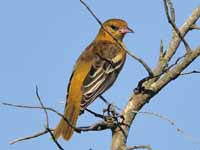
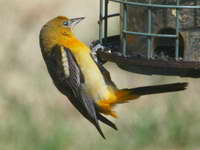

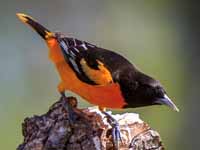
Oriole,_Bar-winged Icterus maculialatus
Description: The bar-winged oriole has black upperparts and a black hood. It has a white wing-bar; orange underparts. The bar-winged oriole is up to 23 cm long.
Range: Mexico, El Salvador, Guatemala, Honduras.
Habitat: Open forests with a preferene for oak trees.
Diet: Probably fruit, insects, nectar.
Conservation status: Least Concern.
Image by: 1) Amy McAndrews - Chiapas 2) Francesco_Veronesi - MexicoRange: Mexico, El Salvador, Guatemala, Honduras.
Habitat: Open forests with a preferene for oak trees.
Diet: Probably fruit, insects, nectar.
Conservation status: Least Concern.
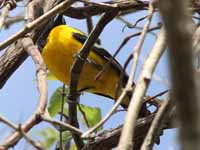
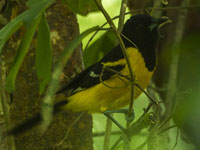
Oriole,_Black-backed Icterus abeillei
Description: The male black-backed oriole has black upperparts with much white showing on the wings. The head is mostly black with an small orange supercilium and orange malar region. The throat is black in the center and orange on the sides. He has orange-yellow underparts and black flanks. The female has yellow-brown upperparts and dull orange-yellow underparts. The black-backed is about 19 cm long. The similar male Baltimore oriole has no orange on its throat. The female black-backed has more white wing-bars than the female Baltimore oriole.
Range: Mexico.
Habitat: Arid to humid forests.
Diet: Insects, spiders, fruit, nectar.
Conservation status: Least Concern.
Image by: 1) Pablo Leautaud 2) Roberto_MonroyRange: Mexico.
Habitat: Arid to humid forests.
Diet: Insects, spiders, fruit, nectar.
Conservation status: Least Concern.
1) Female 2, 3, 4) Male
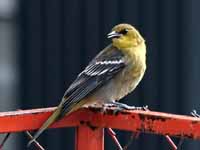
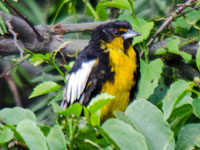
Oriole,_Black-cowled Icterus prosthemelas
Description: The male black-cowled oriole has mainly black upperparts. It also has a black head, neck, breast, and tail. The belly is yellow as are the rump and a shoulder patch. The female only has black on her face and fore-neck. She has olive-green upperparts and mainly yellow underparts. The black-cowled oriole is up to 21 cm long.
Range: Southern Mexico to western Panama.
Habitat: Forest edges, other woodlands, plantations.
Diet: Insects, fruits, nectar.
Conservation status: Least Concern.
Image by: 1) Chris Jimenez 2) Francesco Veronesi 3) Stan Lupo - Costa Rica 4) Dominic_SheronyRange: Southern Mexico to western Panama.
Habitat: Forest edges, other woodlands, plantations.
Diet: Insects, fruits, nectar.
Conservation status: Least Concern.
1) Female 2, 3, 4) Male



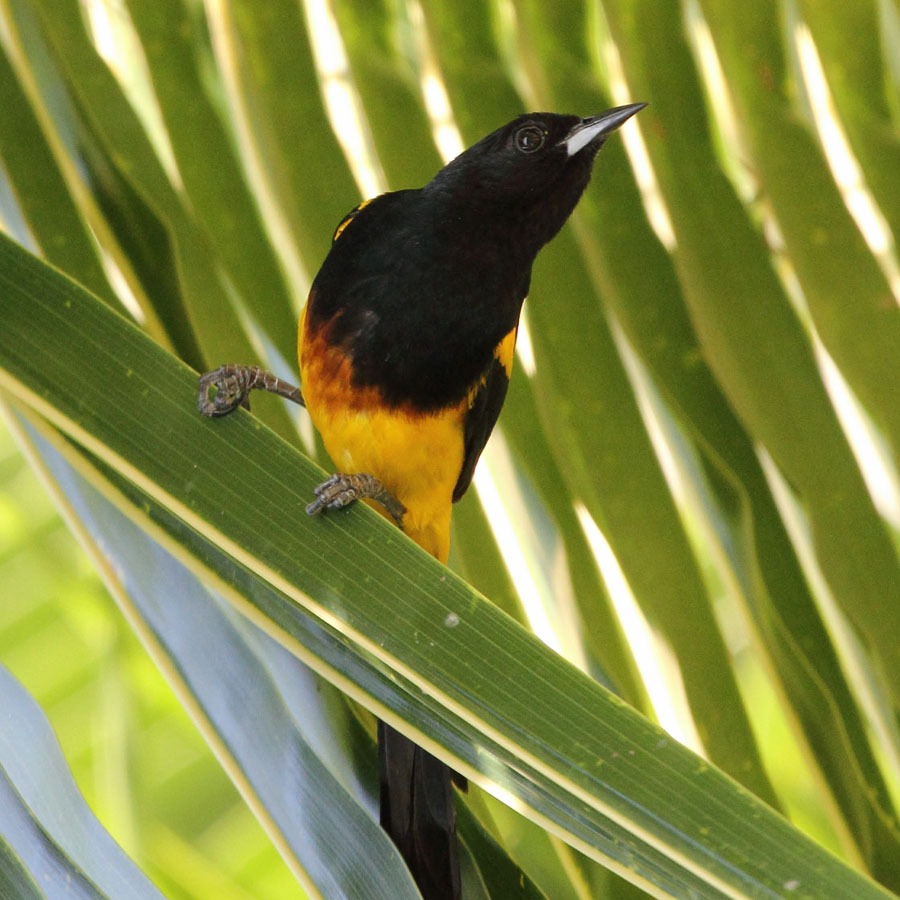
Oriole,_Black-vented Icterus wagleri
Description: The black-venter oriole has mainly black upperparts, head, neck, and tail. The rest of the underparts are orange-yellow. Its black vent is usually hidden. The similar female is duller. The black-vented oriole is up to 23 cm long.
Range: El Salvador, Guatemala, Honduras, Mexico, Nicaragua.
Habitat: Usually open dry woodland in the foothills, but also lower and more humid areas.
Diet: Insects, fruits, nectar.
Conservation status: Least Concern.
Image by: 1) Ron Knight - Mexico 2) Jeff_WhitlockRange: El Salvador, Guatemala, Honduras, Mexico, Nicaragua.
Habitat: Usually open dry woodland in the foothills, but also lower and more humid areas.
Diet: Insects, fruits, nectar.
Conservation status: Least Concern.
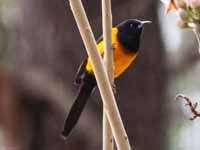
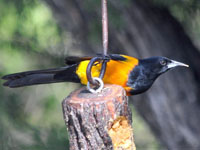
Oriole,_Bullock's Icterus bullockii
Description: The male Bullock's oriole has a black crown, nape, back, throat, and black eye-line. There is a white wing patch. The rest of the plumage is orange. The female has an olive crown and grey-brown upperparts. She has a dull yellow breast and a whitish belly. The Bullock's oriole is up to 19 cm long. The similar male Baltimore oriole has less white on wings The female Bullock's oriole has a line to the rear of its eyes; the female Baltimore oriole has neglible eye-line.
Range: Western North America.
Habitat: The habitat varies considerably over its large range.
Diet: Mainly insects; also fruit and nectar.
Conservation status: Least Concern.
Image by:
1) Alan Vernon - California 2, 3) J N Stuart - New Mexico 4) Kevin Cole- Atascadero Lake Range: Western North America.
Habitat: The habitat varies considerably over its large range.
Diet: Mainly insects; also fruit and nectar.
Conservation status: Least Concern.
1) Female 2) Juvenile male 3, 4) Male

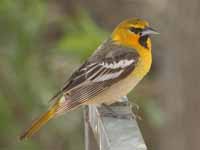
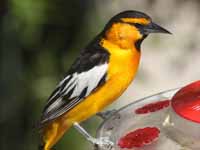
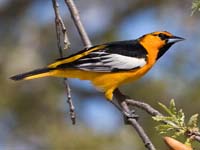
Oriole,_Cuban Icterus melanopsis
Description: The Cuban oriole has mainly black plumage with yellow shoulders, lower belly, rump, and leg tufts. The Cuban oriole is about 20 cm long.
Range: Cuba.
Habitat: Dry or moist forests and mangroves.
Diet: Insects, fruits, nectar.
Conservation status: Least Concern.
Image by: 1) Dave_Curtis 2) Allan Hopkins 3) Dino_KanlicRange: Cuba.
Habitat: Dry or moist forests and mangroves.
Diet: Insects, fruits, nectar.
Conservation status: Least Concern.
1/ 2) Juvenile
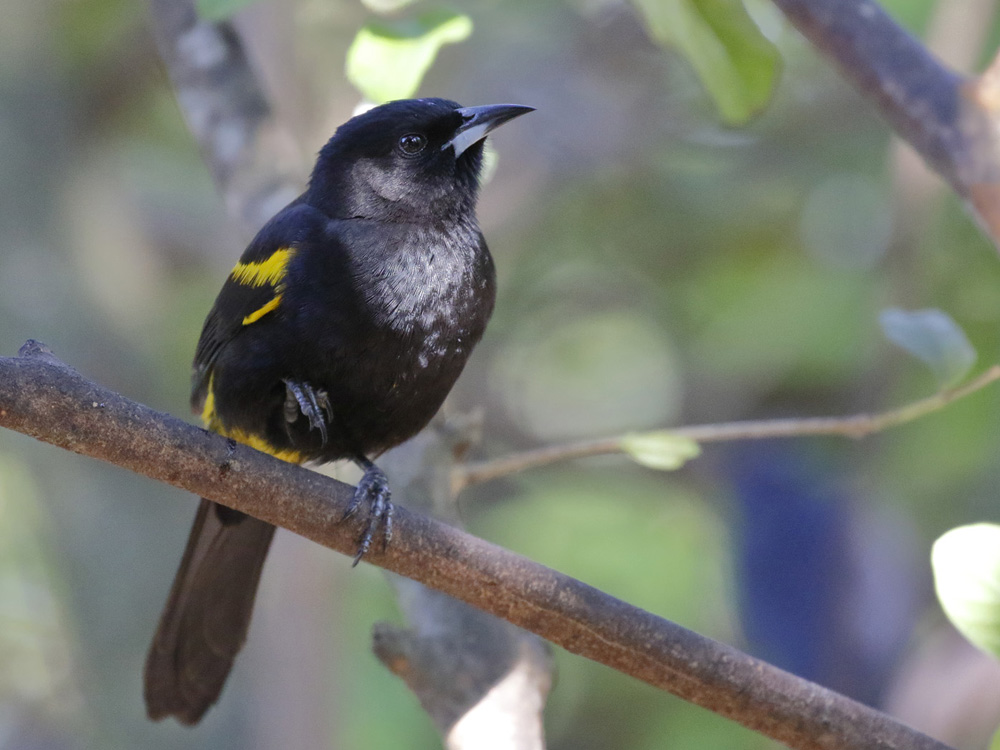
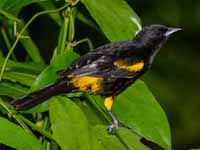
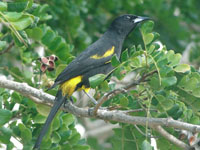
Oriole,_Epaulet Icterus cayanensis
Description: The epaulet oriole has all black plumage except for a yellow shoulder stripe (hence the name epaulet). The epaulet oriole is about 22 cm long. The similar moriche oriole, which is often considered a subspecies, has a yellow shoulder stripe and a yellow partial hood. The variable oriole, which used to be considered a subspecies of the epaulet, has chestnut shoulders.
Range: Northern and central South America.
Habitat: Edges of primary forest, other woodlands with large trees, treed swamps.
Diet: Probably insects, fruits, nectars.
Conservation status: Least Concern.
Image by: 1) Francesco_Veronesi - BrazilRange: Northern and central South America.
Habitat: Edges of primary forest, other woodlands with large trees, treed swamps.
Diet: Probably insects, fruits, nectars.
Conservation status: Least Concern.

Oriole, Hispaniola Icterus dominicensis
Description: The Hispaniola oriole has mainly black plumage. It has a yellow shoulder patch, rump, and yellow upper-tail coverts. The Hispaniola oriole is about 21 cm long.
Range: Hispaniola.
Habitat: Broadleaf forests or coffee plantations mixed with palm.
Diet: Insects, fruits, nectar.
Conservation status: Least Concern.
Image by: 1) Ron Knight Range: Hispaniola.
Habitat: Broadleaf forests or coffee plantations mixed with palm.
Diet: Insects, fruits, nectar.
Conservation status: Least Concern.
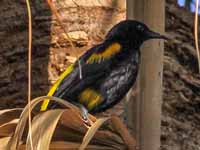
Oriole,_Hooded icterus cucullatus
Description: The male hooded oriole has a black upperparts including black wings with white wing-bars. The tail, face, and throat are also black. The black bill is slightly down-turned. It has an orange hood and underparts. The female has olive-green upperparts and yellowish underparts. The hooded oriole is 18 to 20 cm long. The similar Altamira oriole has more less black on its cheeks.
Range: Southwestern North America.
Habitat: Open treed areas. It especially likes palms.
Diet: Insects, berries, nectar.
Conservation status: Least Concern.
Image by: 1) Tony_Castro 2) Dennis Jarvis - Mexico
3) Alan D. Wilson - Arizona 4) Carl_BergerRange: Southwestern North America.
Habitat: Open treed areas. It especially likes palms.
Diet: Insects, berries, nectar.
Conservation status: Least Concern.
1, 2) Female 3, 4) Male
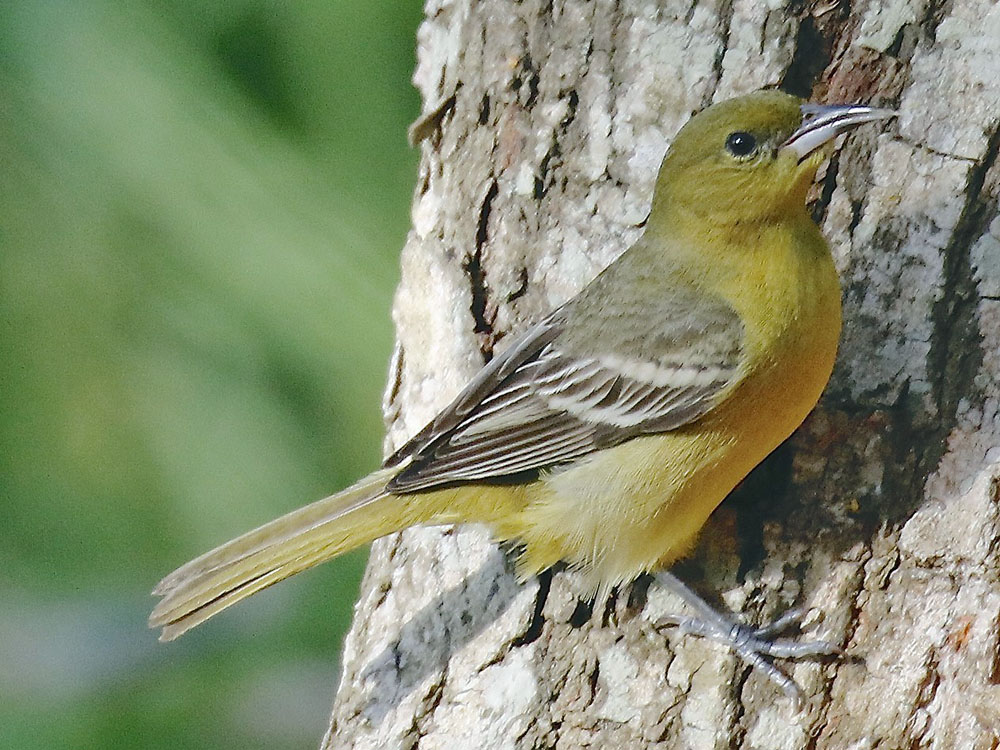
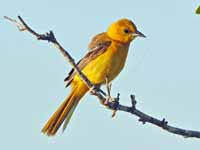
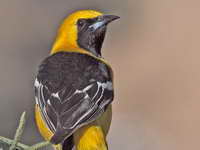
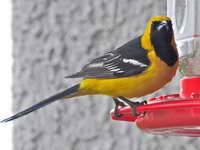
Oriole,_Jamaican Icterus leucopteryx
Description: The Jamaican oriole has is mostly yellow, brighter on the underparts. It has a black mask, bib, and black wings that have a white patch. The female is similar but duller. The Jamaican's oriole is about 21cm long.
Range:Jamaican
Habitat: Most types of wooded areas, except not magroves.
Diet: Mainly insects; also fruit and nectar.
Conservation status: Least Concern.
Image by: 1) Some_Guy 2, 3) Dick Daniels - Rockwell Feeding Station, Negril, Jamaica Range:Jamaican
Habitat: Most types of wooded areas, except not magroves.
Diet: Mainly insects; also fruit and nectar.
Conservation status: Least Concern.
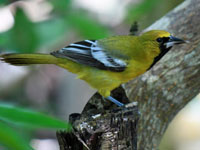
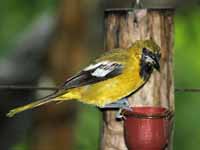
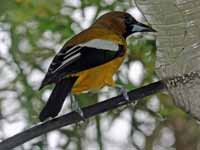
Oriole,_Martinique Icterus bonana
Description: The Martinique oriole has black upperparts, wings, and tail. It has a dark cinnamon head, neck, and dreast. The belly is reddish-orange. The Martinique oriole is about 20 cm long.
Range: Martinique - island in eastern Caribbean.
Habitat: Forests and plantations.
Diet: Insects, fruit, nectar.
Conservation status:It is listed as Vulnerable because of deforestation and the shiny cowbird utilizes 70% of these oriole nests each year.
Image by:1) BuffonRange: Martinique - island in eastern Caribbean.
Habitat: Forests and plantations.
Diet: Insects, fruit, nectar.
Conservation status:It is listed as Vulnerable because of deforestation and the shiny cowbird utilizes 70% of these oriole nests each year.

Oriole,_Montserrat Icterus oberi
Description: The male Montserrat oriole has black upperparts, head, and upper-breast. It has a tawny-orange lower-breast, belly, and rump. The female has dull greenish upperparts and yellowish-tawny underparts. The Montserrat oriole is up to 21 cm long.
Range: Montserrat which is in the Lesser Antilles.
Habitat: Dry forests and mangroves.
Diet: Insects, spiders, snail. Also fruits.
Conservation status: It is listed as Vulnerable due to a volcano eruption that reduced its habitat area.
Image by: 1) Tavez Ayner 2) unknown 3) Neil Phillips 4) Drew AveryRange: Montserrat which is in the Lesser Antilles.
Habitat: Dry forests and mangroves.
Diet: Insects, spiders, snail. Also fruits.
Conservation status: It is listed as Vulnerable due to a volcano eruption that reduced its habitat area.
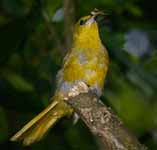
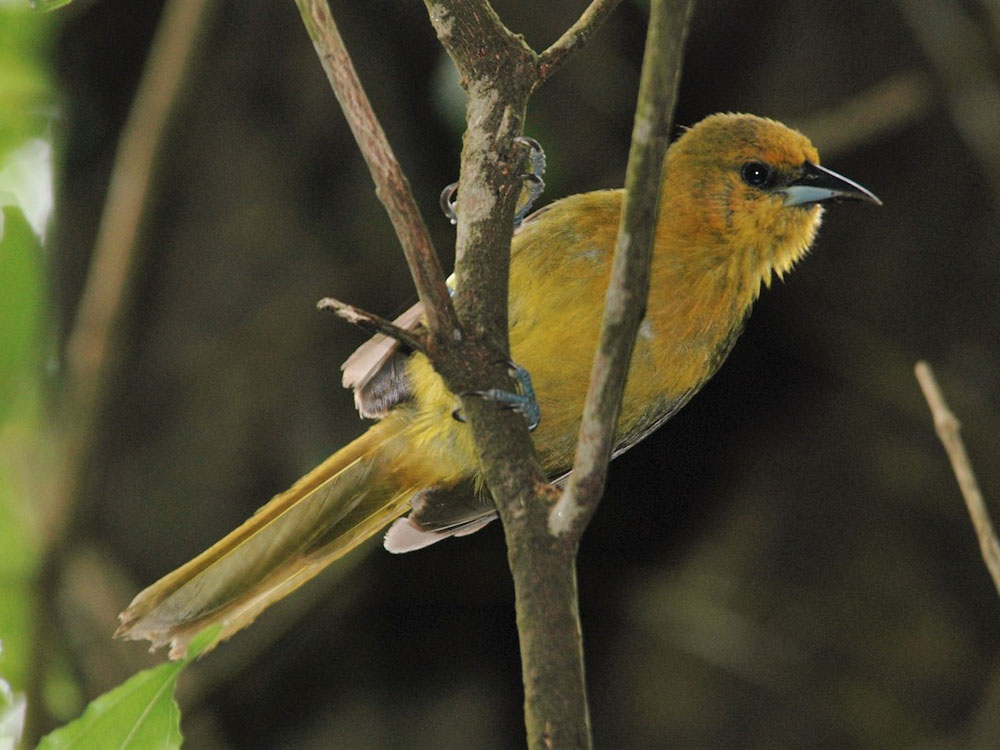


Oriole,_Moriche Icterus chrysocephalus also Icterus cayanensis chrysocephalus
Description: The moriche oriole has mainly black plumage. It has a yellow shoulder stripe, yellow partial hood, and a yellow rump. The moriche oriole is about 22 cm long. It is also considered a subspecies of the epaulet oriole which lacks the yellow partial hood.
Range: Northeastern South America.
Habitat: Forests, savannah, swamps where the moriche palm occurs.
Diet: Mainly insects; also fruits, nectars.
Conservation status: Least Concern.
Image by: 1) Nick Athanas 2) Barloventomagico - Venezuela 3) Jerry Oldenettel - VenezuelaRange: Northeastern South America.
Habitat: Forests, savannah, swamps where the moriche palm occurs.
Diet: Mainly insects; also fruits, nectars.
Conservation status: Least Concern.


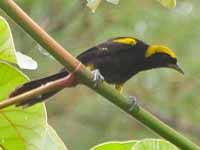
Oriole,_Orchard Icterus spurius
Description: The male orchard oriole has a black head, neck, back, and wings. The underparts and rump are chestnut. The female has olive-green upperparts and yellowish underparts. The orchard oriole is only 15 to 18 cm long.
Range: Central and eastern North America, Central America, and very northern South America.
Habitat: Scattered trees, especially near moving water.
Diet: Insects, spiders, fruits, nectar, seeds.
Conservation status: Least Concern.
Image by: 1, 2) Kelly Azar - Pennsylvanila 3) Dan Pancamo 4) MitchMccRange: Central and eastern North America, Central America, and very northern South America.
Habitat: Scattered trees, especially near moving water.
Diet: Insects, spiders, fruits, nectar, seeds.
Conservation status: Least Concern.
1, 2) Female 3, 4) Male
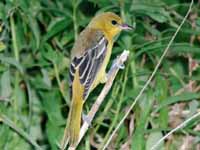
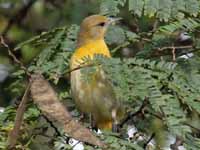
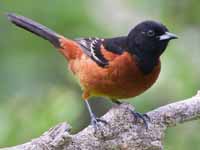
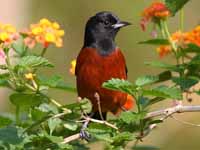
Oriole,_Orange Icterus auratus
Description: The orange oriole has mainly orange plumage except for a black bib, tail, and black wings with white edges. The orange oriole is up to 21 cm longl.
Range: Mexico in the Yucatan Peninsula and Belize.
Habitat: Dry forests and heavily degraded former forests.
Diet: Probably insects, fruits, nectar.
Conservation status: Least Concern.
Image by: 1, 2) Amy McAndrewsRange: Mexico in the Yucatan Peninsula and Belize.
Habitat: Dry forests and heavily degraded former forests.
Diet: Probably insects, fruits, nectar.
Conservation status: Least Concern.
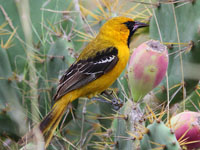
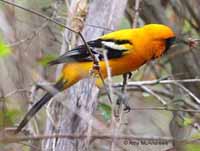
Oriole,_Orange-crowned Icterus auricapillus
Description: The orange-crowned oriole has black upperparts, bib. and tail. It has a yellowish-orange crown, nape, and underparts. The orange-crowned oriole is about 18 cm long.
Range: Panama, Columbia, Venezuela.
Habitat: Forest edges, open area with trees available.
Diet: Insects, fruits, nectar.
Conservation status: Least Concern.
Image by: 1) Felix_Uribe - Columbia 2, 3) Barloventomagico Range: Panama, Columbia, Venezuela.
Habitat: Forest edges, open area with trees available.
Diet: Insects, fruits, nectar.
Conservation status: Least Concern.
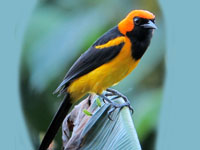
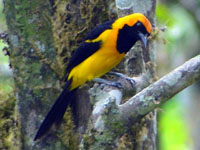

Oriole,_Puerto Rican Icterus portoricensis
Description: The Puerto Rican oriole has mainly black plumage with a yellow shoulder, lower belly, rump, and leg tufts. The closely related Hispaniolan oriole (Icterus dominicensis) and Bahama oriole (Icterus northropi) have more yellow on their bodies, and the Cuban oriole (Icterus melanopsis) has more black. The Puerto Rican oriole is up to 22 cm long.
Range: Puerto Rico.
Habitat: Forest edges, woodlands, other areas with some trees available.
Diet: Insects, fruits, nectar.
Conservation status: Least Concern.
Image by: 1) Jardin BoricuaRange: Puerto Rico.
Habitat: Forest edges, woodlands, other areas with some trees available.
Diet: Insects, fruits, nectar.
Conservation status: Least Concern.
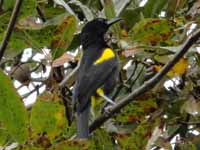
Oriole,_Saint Lucia Icterus laudabilis
Description: The Saint Lucia oriole has mainly black upperparts with yellowish-orange on the shoulders and lower-back. It has a black head, neck, and breast. The belly is also yellowish-orange. The Saint Lucia oriole is up to 22 cm long.
Range: Saint Lucia (an island country in the eastern Caribbean).
Habitat: Seems adapted to most of the island's habitats.
Diet: Insects, fruits, nectar.
Conservation status: It is listed as Endangered as its population is around 1000 and its range is small.
Image by: 1) Joseph Smit Range: Saint Lucia (an island country in the eastern Caribbean).
Habitat: Seems adapted to most of the island's habitats.
Diet: Insects, fruits, nectar.
Conservation status: It is listed as Endangered as its population is around 1000 and its range is small.
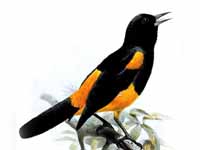
Oriole,_Scott's Icterus parisorum
Description: The male Scott's oriole has a black back, head, and breast. The rest of the underparts are yellow and there is a lot of white visible on the folded wings The female has olive-green upperparts with white wing-bars and white edges to the wings. She has yellowish-green underparts. The Scott's oriole is up to 22 cm long. The similar male Audubon's oriole does not have a black back; the female Audubon's oriole has a black head.
Range: Southwestern United States to central Mexico.
Habitat: Arid montane areas with juniper and yuccas.
Diet: Mainly insects; also fruit and nectar.
Conservation status: Least Concern.
Image by:
1) Phillip Cowan - California 2) William_Levine 3) Reago-McClarren 4) Len_Worthington - ArizonaRange: Southwestern United States to central Mexico.
Habitat: Arid montane areas with juniper and yuccas.
Diet: Mainly insects; also fruit and nectar.
Conservation status: Least Concern.
1. 2) Female 3, 4) Male
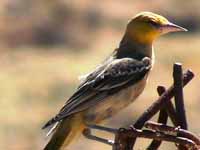
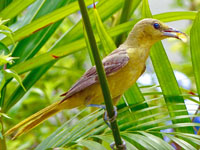
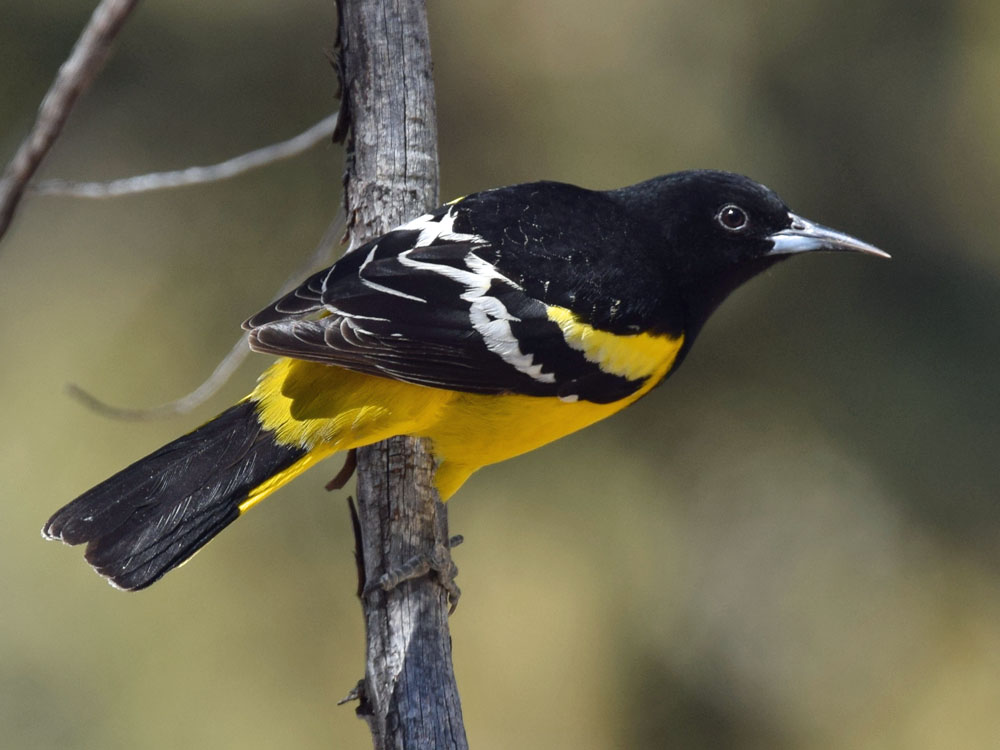
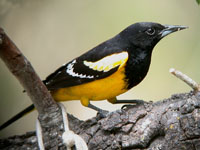
Oriole,_Spot-breasted Icterus pectoralis
Description: The spot-breasted oriole has an orange head with a black face. The upperparts are mostly black with a white patch on the closed wings. It has a black throat and black on the breast - a black patch surrounded by black spots. The rest of the underparts are orange. The spot-breasted oriole is up to 24 cm long. The similar female is somewhat duller. The similar altamira does not have spots on its breast.
Range: Florida (introduced), southern Mexico, and much of the Pacific side of Central America.
Habitat: Forests and even heavily logged areas.
Diet: Insects, fruits, nectar.
Conservation status: Least Concern.
Image by: 1, 3) Len Blumin - Costa Rica 2) Dominic Sherony - Guatemala 4) Dan Irizarry - FloridaRange: Florida (introduced), southern Mexico, and much of the Pacific side of Central America.
Habitat: Forests and even heavily logged areas.
Diet: Insects, fruits, nectar.
Conservation status: Least Concern.
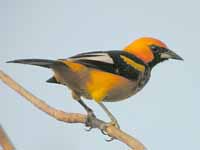
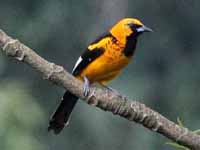
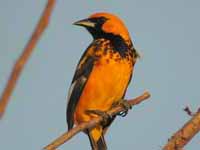
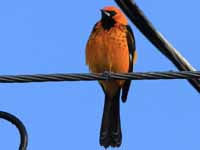
Oriole,_Streak-backed Icterus pustulatus
Description: The streak-backed oriole has an orange head and underparts. Its orange back has black streaks. The tail, face, throat, and lores are black. It has black wings with white edgings.
The streaked back is an identifying feature. The streak-backed oriole is about 20 cm long.
Range: Mexico and Central America.
Habitat: Open arid woodland. Also savanna, grassland, shrubland.
Diet: Insects, fruits, nectar.
Conservation status: Least Concern.
Image by: 1) Don_Loarie 2) Marcel Holyoak -
California 3) Don_LoarieRange: Mexico and Central America.
Habitat: Open arid woodland. Also savanna, grassland, shrubland.
Diet: Insects, fruits, nectar.
Conservation status: Least Concern.
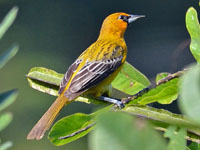
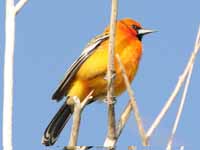

Oriole,_Variable Icterus pyrrhopterus
Description: The variable oriole has mainly black plumage. It has variable colored shoulders, usuallly chestnut and sometimes yellow. One subspecies also has yellow thighs. It is about 20 cm long. The variable oriole used to be subspecies of epaulet oriole which has has yellow shoulders.
Range: Mainly Brazil. Also Argentina, Bolivia, Paraguay, Uruguay.
Habitat: A variety of forests.
Diet: Insects, fruit, nectar.
Conservation status: Least Concern.
Image by: 1) Nick Athanas - Argentina 2) Claudio_Timm 3) Bernard_Dupont - BrazilRange: Mainly Brazil. Also Argentina, Bolivia, Paraguay, Uruguay.
Habitat: A variety of forests.
Diet: Insects, fruit, nectar.
Conservation status: Least Concern.
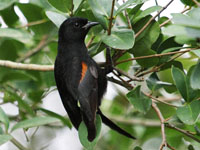


Oriole,_White-edged Icterus graceannae
Description: The white-edged oriole has mainly orange-yellow plumage. It has a black mask and bib that extends to the upper-breast. The wings are black with white edges and the tail is also black. It has a mainly black mantle. The white-edged oriole is about 20 cm long.
Range: Ecuador and Peru.
Habitat: Dry woodlands even extending into the desert.
Diet: Probably insects and fruit.
Conservation status: Least Concern.
Image by: 1, 2) Dick Daniels- Birds of Eden. Identified by Charlie Westerinen 3) Francesco Veronesi - Ecuador 4) Tom_Friedel (BirdPhotos.com)Range: Ecuador and Peru.
Habitat: Dry woodlands even extending into the desert.
Diet: Probably insects and fruit.
Conservation status: Least Concern.
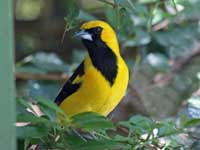
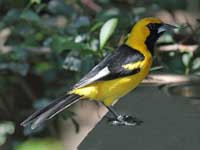
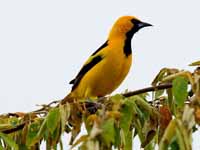

Oriole,_Yellow Icterus nigrogularis
Description: The yellow oriole has mainly yellow plumage. It has black lores, throat, bib, wings, and tail. There are some white tips on the wings. It is about 21 cm long.
Range: Northern South America.
Habitat: Open, mixed pine-oak woodlands and dry scrub forest; usually under 1000 m.
Diet: Insects, fruit and nectar.
Conservation status: Least Concern.
Image by: 1) Alejandro_Tamayo - Columbia 2) Stanley Tempro 3, 4) BarloventomagicoRange: Northern South America.
Habitat: Open, mixed pine-oak woodlands and dry scrub forest; usually under 1000 m.
Diet: Insects, fruit and nectar.
Conservation status: Least Concern.
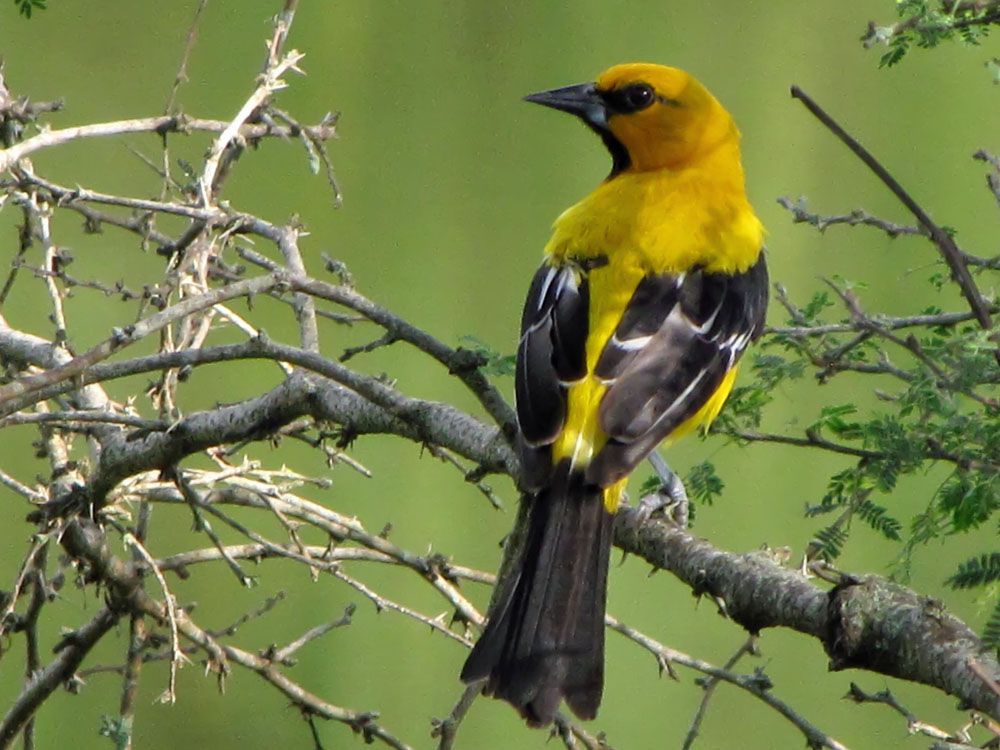
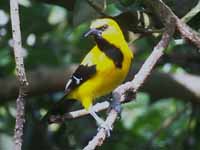
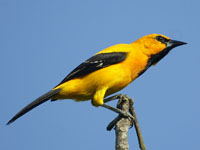
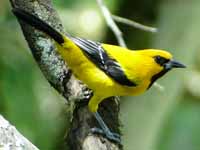
Oriole,_Yellow-backed Icterus chrysater
Description: The yellow-backed oriole has black wings, face, throat, and tail. It has a bright yellow back and underparts. The female is similar to the male but the yellow may have a greenish tinge. This is a large oriole, up to 24 cm long.
Range: Central American, northern South America.
Habitat: Open, mixed pine-oak woodlands and dry scrub forest; usually under 1000 m.
Diet: Mainly insects. Also fruit and nectar.
Conservation status: Least Concern.
Image by: 1, 2) Jerry Oldenettel - Belize 3) Patty McGann 4) Nick Athanas - ColumbiaRange: Central American, northern South America.
Habitat: Open, mixed pine-oak woodlands and dry scrub forest; usually under 1000 m.
Diet: Mainly insects. Also fruit and nectar.
Conservation status: Least Concern.
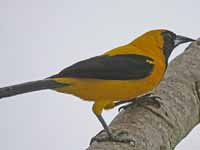
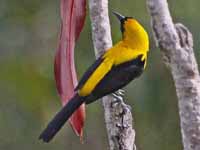
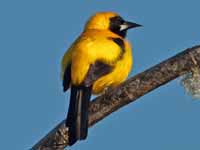
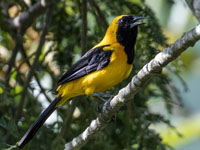
Oriole,_Yellow-tailed Icterus mesomelas
Description: The yellow-tailed oriole has mainly yellow plumage. It has a black mantle, wings, lower face, and upper breast. The tail is mainly black on the top with some yellow; the under-tail is all yellow. This species has the most yellow on its tail of all New World orioles. The yellow-tailed oriole is a large oriole, 22 to 23 cm long.
Range: Southern Mexico to Peru and northwestern Venezuela.
Habitat: Humid treed areas including swamps. Likes to be near water.
Diet: Insects, fruits, nectar.
Conservation status: Least Concern.
Image by: 1) Nick Athanas - Ecuador 2) bgv23 3) Billtacular - PanamaRange: Southern Mexico to Peru and northwestern Venezuela.
Habitat: Humid treed areas including swamps. Likes to be near water.
Diet: Insects, fruits, nectar.
Conservation status: Least Concern.

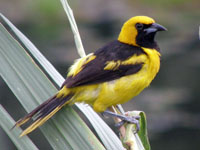
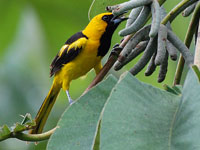
Troupial,_Campo Icterus jamacaii
Description: The campo troupials has a black head, nape, bib and tail. The upperparts are mainly black except for the orange upper-nape and some white on the wings. The underparts are orange and it has yellow eyes. It has a black bill with substantial blue-grey near the base of the lower-bill. The campo troupial is about 24 cm long. It does not does not build its own next, instead using an old one or evicting a current owner. It uses a nest that has a covering.
Range: Eastern Brazil.
Habitat: Dry woodlands including semi-desert.
Diet: Insects, fruits, nectar.
Conservation status: Least Concern.
Image by: 1) Dilson Santos 2) Egon_Fink 3) Instituto Ultimos RefugiosRange: Eastern Brazil.
Habitat: Dry woodlands including semi-desert.
Diet: Insects, fruits, nectar.
Conservation status: Least Concern.


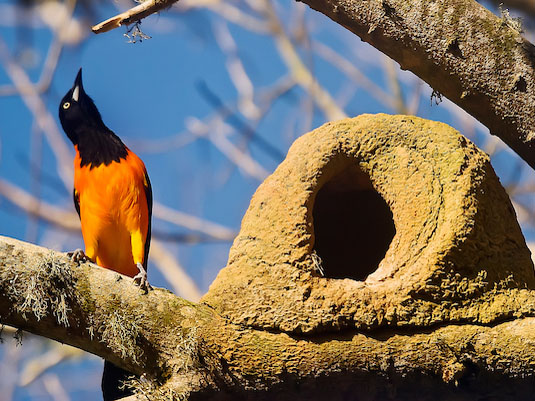
Troupial,_Orange-backed Icterus croconotus
Description: The orange-backed troupial has a black face, throat, back, and tail. The wings also black with some white visible while closed. It has an orange hood, orange underparts, and yellow eyes with a blue wedge behind them. The black bill has substantial blue-grey near the base of the lower-bill. The orange-backed troupial is about 23 cm long. It does not does not build its own next, instead using an old one or evicting a current owner. It uses a nest that has a covering. The similar campo troupial has a black head.
Range: East of the Andes in Guyana, Brazil, Paraguay, and eastern Ecuador, Bolivia, and Peru.
Habitat: Forest areas near water.
Diet: Insects, fruits, nectar.
Conservation status: Least Concern.
Image by: 1)Andreas Trepte 2) Charles Sharp - Brazil 3) Carlos_HenriqueRange: East of the Andes in Guyana, Brazil, Paraguay, and eastern Ecuador, Bolivia, and Peru.
Habitat: Forest areas near water.
Diet: Insects, fruits, nectar.
Conservation status: Least Concern.
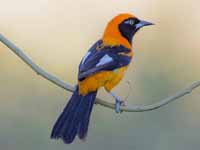
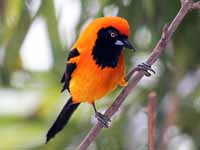
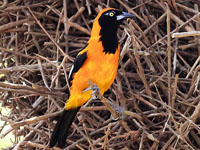
Troupial,_Venezuelan Icterus icterus
Description: The Venezuelan troupial has a black head, throat, back, and tail. The wings also black with substantial white visible while closed. It has an orange collar and orange underparts. The yellow eyes are surrounded by blue. The black bill has substantial blue-grey near the base of the lower-bill. The Venezuelan troupial is up to 27 cm long. It does not does not build its own next, instead using an old one or evicting a current owner. It uses a nest that has a covering.
Range: Mainly in Venezuela. Also Colombia, and the Caribbean islands of Aruba, Curaçao, Bonaire, Trinidad, and Puerto Rico.
Habitat: Dry woodlands, scrubland, and savanna.
Diet: Mostly insects, also fruits, nectar, seeds.
Conservation status: Least Concern.
Image by: 1) CP_Ewing 2) Jerry Oldenettel - Venezuela 3) Nate_Swick 4) Dick Daniels - Woodland Park Zoo, SeattleRange: Mainly in Venezuela. Also Colombia, and the Caribbean islands of Aruba, Curaçao, Bonaire, Trinidad, and Puerto Rico.
Habitat: Dry woodlands, scrubland, and savanna.
Diet: Mostly insects, also fruits, nectar, seeds.
Conservation status: Least Concern.

